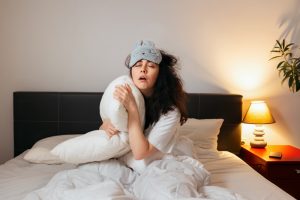Your sleep tracker can not only provide you with information about your sleep habits, but also about chronic conditions such as diabetes and sleep apnea, as well as diseases such as COVID-19. This is one of the findings of a study in which data from 5 million nights of sleep from around 33,000 people was analyzed. Based on the new analyses, the researchers identified five main types of sleep, which they called sleep phenotypes and which can be further subdivided into 13 subtypes. The researchers also found that how and how often a person switches between sleep phenotypes could provide two to ten times more information for detecting health conditions than relying on a person’s average sleep phenotype alone.
Even Small Changes in Sleep Quality Help to Identify Health Risks
Using data collected by the Oura Ring – a smart ring that records sleep, skin temperature and other information – the researchers examined individuals over several months and determined whether they suffered from chronic diseases such as diabetes and sleep apnea or illnesses such as COVID-19 and influenza.
The research team led by Benjamin Smarr, one of the lead authors of the study and a faculty member at the Jacobs School of Engineering and the Halicioglu Data Science Institute at the University of California San Diego, found that people frequently switched between different sleep phenotypes over time, reflecting a change in a person’s health status, and through the data-driven sleep landscape created by the researchers is a kind of travel diary of a person.
They found that small changes in sleep quality helped to identify health risks. These small changes would not show up in an average night or in a questionnaire. This shows how wearables can help identify risks that would otherwise be overlooked. In addition, the researchers emphasized that long-term tracking of sleep changes at the population level could provide new insights relevant to public health, such as whether certain changes in sleep patterns through these sleep landscapes can provide early warnings of chronic disease or susceptibility to infection.
The research team’s work is based on new analyses of the TemPredict dataset from the University of California, San Francisco, which was created using data from people who wore the commercially available Oura ring during the COVID-19 pandemic in 2020.
Five different sleep types
These are the five sleep phenotypes that the researchers identified based on data from 5 million nights of sleep in around 33,000 people. Although many factors went into the study, the researchers also identified some trends that help to intuitively distinguish the 5 sleep phenotypes.
Phenotype 1: What we call “normal” sleep. In this phenotype, people sleep about eight hours uninterrupted for at least six days in a row. This is the sleep type recommended by the National Institutes of Health and the one the researchers found most frequently.
Phenotype 2: Half of the nights people sleep uninterrupted, while the other half they sleep only short periods of less than three hours.
Phenotype 3: Most people sleep uninterrupted, but about one night a week their sleep is interrupted. The interrupted night is characterized by a period of relatively long sleep of about five hours and a period of short sleep of less than three hours.
Phenotype 4: Here too, people usually sleep continuously. However, they experience rare nights in which long sleep phases are separated by waking up in the middle of sleep.
Phenotype 5: They only sleep for very short periods each night. This phenotype was the rarest found by the researchers and represents extremely disturbed sleep.
Tracking the Changes in Sleep Type
To measure how sleep phenotypes changed over time, the researchers constructed a spatial model of all 5 million nights in which the phenotypes were represented as different islands consisting of mostly similar sleep weeks. Over time, different patterns emerged that allowed the researchers to model the paths of each individual between the islands. This showed that people with chronic conditions such as diabetes and sleep apnea could not be distinguished by their average phenotype. Rather, it was the frequency with which they switched between islands in this sleep landscape. Even if a person rarely changed their phenotype, the fact that they did could provide useful information about their health.
The data showed that it is rare for most people to go several months without a few nights of disturbed sleep. The experts found that the small differences in how sleep disturbances occur can tell a lot. Even though these disorders are rare, their frequency is telling. So it’s not just about whether you sleep well or not – it’s the sleep patterns over time that hide the most important information.
Conversely, people did not tend to persist in patterns defined by interrupted sleep. But how often they had certain interrupted sleep patterns says a lot about how well they are doing.
Previous Research Less Accurate
In this new work, the research team modified the technique used in a previous study, the largest comparable study on sleep to date, which analyzed around 103,000 nights from the UK Biobank. This earlier study looked at the timing of falling asleep and waking up, as well as many related characteristics, and then created a ‘landscape’ relating the nights to each other. However, the earlier researchers failed to take two important things into account: they could not look over time because they only had two to three nights per person, and they could not link the resulting sleep patterns to health outcomes.
In contrast, this new work shows for the first time that researchers can quantify the changing dynamics of people’s sleep over time and use this quantification to give people better insight into their sleep health. The research also suggests that these changes in sleep may indicate a higher risk of a variety of diseases.








